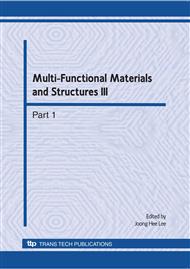p.1259
p.1263
p.1267
p.1271
p.1275
p.1279
p.1283
p.1287
p.1291
Thermally Stable Polyimide/Silica Hybrid: Synthesis, Characterization and Optical Nonlinearity
Abstract:
An intercalation nonlinear-optical (NLO) polyimide was synthesized based on the 3,3’, 4,4’- Bisphenyltetracarboxylic (BPDA) and [(6-nitrobenzothiazole-2-yl)diazenyl]phenyl-1,3- diamine (NBADA). Then, hybrid polymer was synthesized by the sol-gel technique. FT-IR spectroscopy and 29Si NMR were used to characterize the structure of the hybrid. The results revealed that Q3, Q4 and T3 are the major microstructure elements in forming a network structure. The surface morphology, particle size, crystallinity and the thermal stability of the hybrid were investigated using scanning electron microscopy (SEM), transmission electron microscopy (TEM), X-ray diffraction (XRD), thermogravimetric analysis (TGA) and differential scanning calorimetry (DSC). DSC and TGA results showed that the glass transition temperature (Tg) and the decomposition temperature (Td) at 5% mass loss were 243, 359°C and 355, 456°C, respectively. These results showed that the hybrid material had excellent thermal stability than the pure polyimide. The electro-optic coefficients of nonlinear optical polyimide and hybrid were measured at the wavelength of 832 nm. The electro-optic coefficients were 22 and 19pm/V (poling voltage of 3.8KV, 210°C) and the values remained well (retained>93% for more than 100h). The results suggest that the materials have potential applications for high performance optical device.
Info:
Periodical:
Pages:
1275-1278
Citation:
Online since:
August 2010
Authors:
Keywords:
Price:
Сopyright:
© 2010 Trans Tech Publications Ltd. All Rights Reserved
Share:
Citation:


